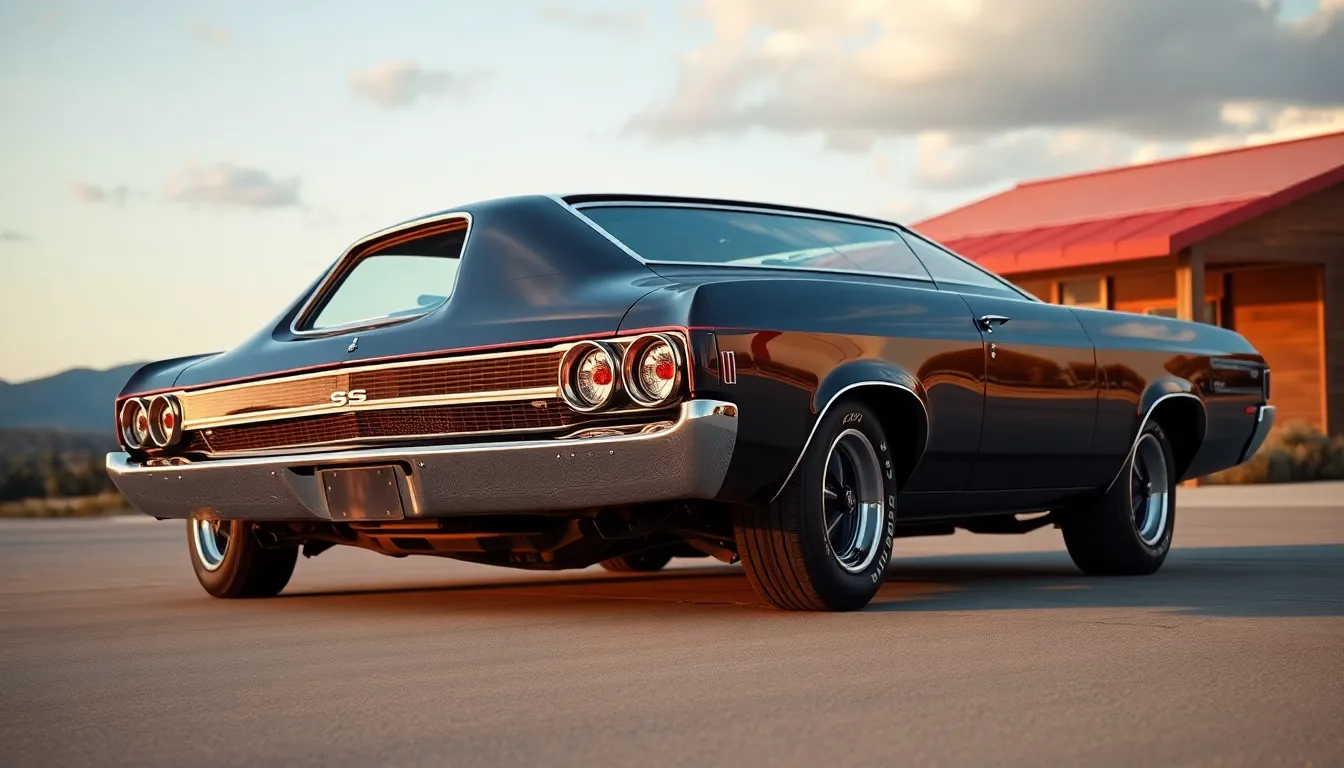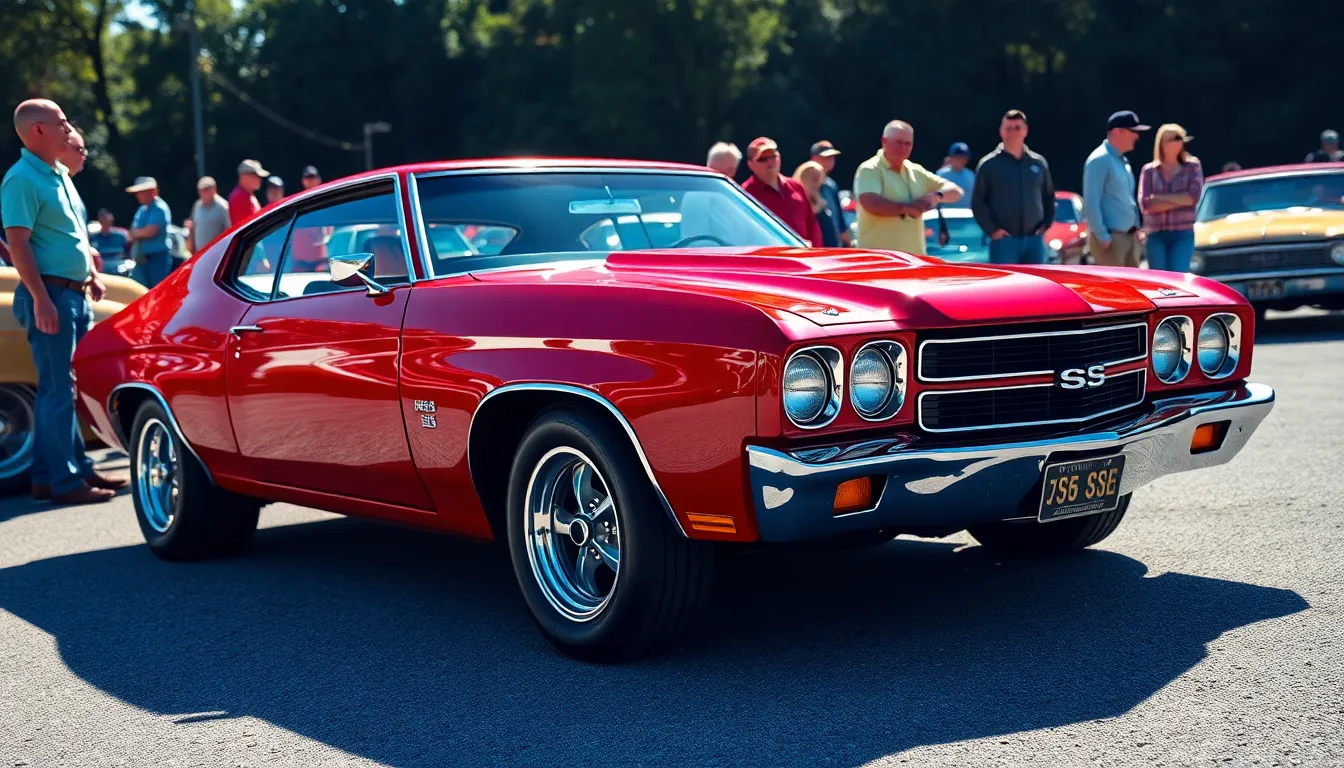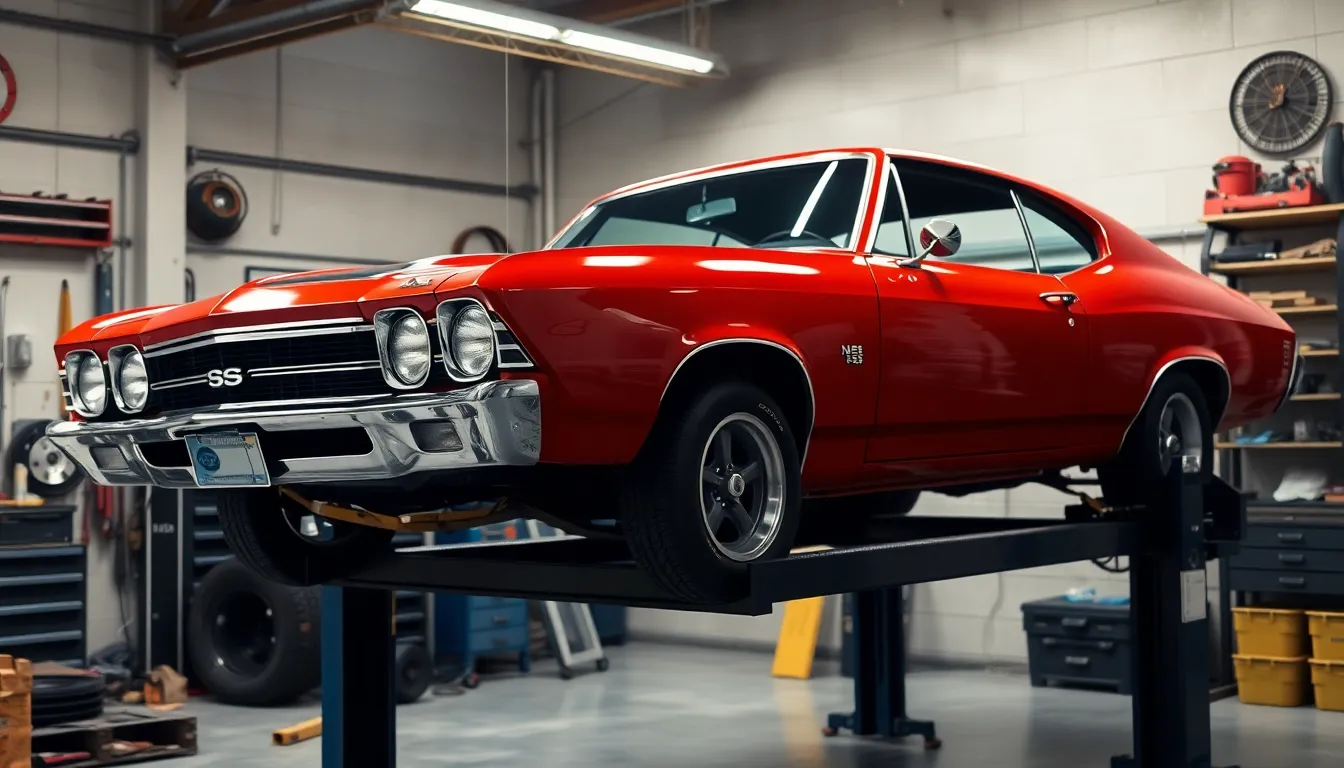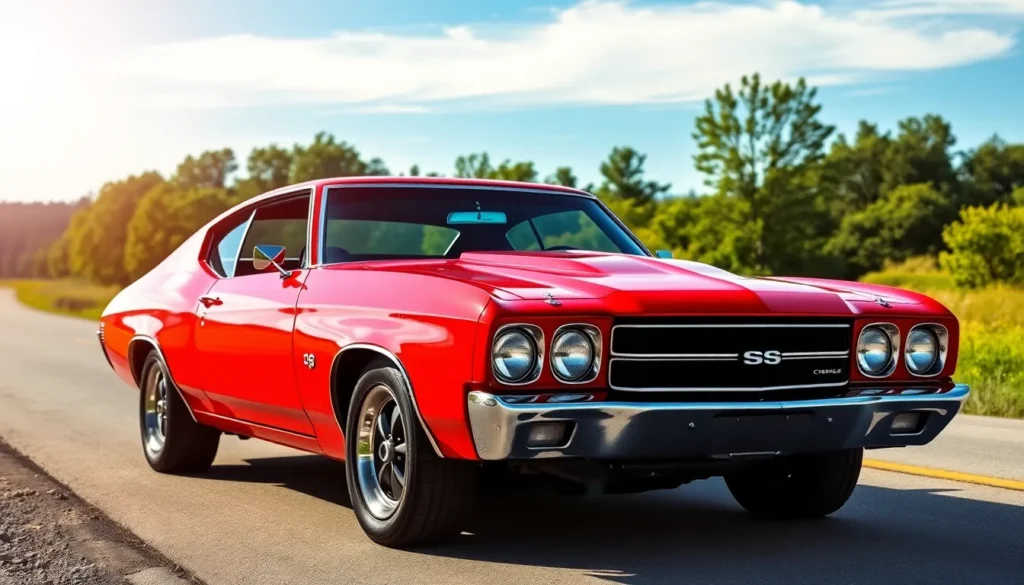When we think about iconic American muscle cars that defined an entire generation the Chevrolet Chevelle SS immediately comes to mind. This legendary beast roamed the streets from 1964 to 1977 leaving tire marks and unforgettable memories in its wake. We’re talking about a car that didn’t just transport you from point A to point B – it launched you there with authority.
The Chevelle SS wasn’t just another pretty face in Chevrolet’s lineup. It packed serious punch under the hood with engine options that could make your heart skip a beat. From the base 396 big-block to the earth-shaking 454 LS6 we witnessed automotive engineering at its finest during the golden age of muscle cars.
Today we’ll dive deep into what made the Chevelle SS so special and why collectors still hunt for these mechanical masterpieces decades later. Whether you’re a seasoned gearhead or just discovering your passion for classic American iron you’re about to learn why this Chevy earned its stripes as a true automotive legend.
History and Evolution of the Chevrolet Chevelle SS
The Chevrolet Chevelle SS underwent three distinct generations from 1964 to 1977, each reflecting changing automotive trends and performance standards. Evolution through these generations showcased Chevrolet’s commitment to muscle car dominance during America’s performance era.
First Generation (1964-1967)
Chevrolet introduced the Chevelle SS in 1964 as the performance variant of their new intermediate car line. The SS designation initially represented an appearance package rather than a performance upgrade, featuring distinctive trim elements and sporty styling cues.
1964 marked the birth of the Chevelle SS with the L74 283 cubic inch V8 engine producing 220 horsepower. Buyers could upgrade to the L76 327 cubic inch V8 delivering 300 horsepower for enhanced performance capabilities.
1965 brought the first major performance milestone with the introduction of the 396 big block V8 engine option. The L35 396 generated 325 horsepower while the L78 396 produced 375 horsepower, establishing the Chevelle SS as a legitimate muscle car contender.
Production numbers reflected growing popularity during these early years:
| Year | Total SS Production | Notable Features |
|---|---|---|
| 1964 | 76,860 | First year, appearance package focus |
| 1965 | 101,577 | Introduction of 396 big block |
| 1966 | 72,272 | Refined styling updates |
| 1967 | 63,006 | Final year of first generation |
Styling characteristics defined the first generation through clean lines, dual headlights, and the distinctive SS grille treatment. Chrome accents and SS badging differentiated these models from standard Chevelle variants.
Second Generation (1968-1972)
Redesigned bodywork launched the second generation in 1968 with more aggressive styling and improved aerodynamics. The new platform featured longer wheelbases and wider body dimensions to accommodate larger engines.
1968 established the SS 396 as a separate model line rather than just an option package. Engine choices included the L35 325 horsepower 396, L34 350 horsepower 396, and the legendary L78 375 horsepower 396.
1970 represented the pinnacle of Chevelle SS performance with the introduction of the LS6 454 cubic inch engine. This powerplant generated 450 horsepower and 500 pound feet of torque, making it one of the most powerful production engines ever built.
Performance statistics from the peak years demonstrate exceptional capabilities:
| Engine | Horsepower | Torque | 0-60 mph Time |
|---|---|---|---|
| L78 396 (1970) | 375 hp | 415 lb-ft | 6.0 seconds |
| LS5 454 (1970) | 360 hp | 500 lb-ft | 6.1 seconds |
| LS6 454 (1970) | 450 hp | 500 lb-ft | 5.4 seconds |
Cowl induction hoods became standard on SS models starting in 1969, improving engine breathing and adding visual distinction. Racing stripes, SS badging, and distinctive wheel options further enhanced the performance appearance.
Production reached its highest levels during this generation, with 1969 seeing over 86,000 SS units manufactured. The combination of powerful engines and refined chassis engineering created the definitive muscle car experience.
Third Generation (1973-1977)
Federal emissions regulations transformed the third generation Chevelle SS beginning in 1973. Power outputs decreased significantly as manufacturers adapted to new environmental standards and safety requirements.
1973 marked the transition to SAE net horsepower ratings instead of gross ratings used previously. The LS4 454 engine produced 245 net horsepower, substantially less than previous LS6 specifications but still competitive for the era.
Styling updates reflected changing automotive trends with larger bumpers to meet federal impact standards. The SS appearance package remained available but engine options became increasingly limited through the decade.
Final production years showed declining performance focus:
| Year | Available Engines | Highest Power Output | Production Numbers |
|---|---|---|---|
| 1973 | 350, 454 | 245 hp (LS4 454) | 28,647 |
| 1974 | 350, 454 | 235 hp (LS4 454) | 25,274 |
| 1975 | 350 | 155 hp (L65 350) | 23,000 |
| 1976 | 350 | 165 hp (L65 350) | 21,000 |
1977 concluded the Chevelle SS era as Chevrolet discontinued the model line in favor of the new Monte Carlo and upcoming Malibu platforms. The final SS models featured primarily cosmetic enhancements rather than important performance upgrades.
Collector value today reflects the performance hierarchy established during these three generations, with 1970 LS6 models commanding premium prices and first generation 396 cars maintaining strong market positions.
Engine Options and Performance Specifications

The Chevrolet Chevelle SS offered diverse powertrain configurations that defined American muscle car performance throughout its production run. These engine options evolved significantly across generations, delivering escalating horsepower figures that established the Chevelle SS as a formidable competitor in the muscle car segment.
Small Block V8 Engines
Small block V8 engines provided the foundation for entry-level Chevelle SS models, offering balanced performance and reliability. The L74 283 cubic inch V8 generated 220 horsepower in early 1964 models, serving as the initial SS powerplant before more potent options emerged.
L76 327 cubic inch V8 engines delivered enhanced performance with 300 horsepower output, becoming popular among buyers seeking improved acceleration without the cost premium of big block alternatives. These engines featured hydraulic lifters, four-barrel carburetors, and dual exhaust systems that produced the distinctive muscle car sound signature.
L48 350 cubic inch V8 powerplants appeared in later model years, producing horsepower ratings between 245 and 300 depending on compression ratios and emission control requirements. The 350 small block maintained excellent fuel economy compared to big block variants while providing adequate performance for daily driving scenarios.
Big Block V8 Powerhouses
Big block V8 engines established the Chevelle SS reputation as a legitimate high-performance machine, starting with the revolutionary L78 396 cubic inch powerplant in 1965. This engine produced 375 horsepower with solid lifter camshafts, aluminum intake manifolds, and high-flow cylinder heads that maximized breathing efficiency.
L89 396 engines featured aluminum cylinder heads that reduced weight by approximately 75 pounds while maintaining the same 375 horsepower output as iron-headed L78 variants. These rare engines appeared in limited quantities during 1967 model year production, making them highly sought after by collectors today.
| Engine Code | Displacement | Horsepower | Torque | Production Years |
|---|---|---|---|---|
| L78 396 | 396 cubic inches | 375 hp | 415 lb-ft | 1965-1969 |
| L89 396 | 396 cubic inches | 375 hp | 415 lb-ft | 1967 |
| LS5 454 | 454 cubic inches | 360 hp | 500 lb-ft | 1970-1972 |
| LS6 454 | 454 cubic inches | 450 hp | 500 lb-ft | 1970 |
LS6 454 cubic inch engines represented the pinnacle of Chevelle SS performance, delivering factory-rated 450 horsepower through 11.25:1 compression ratios and aggressive cam profiles. This powerplant achieved quarter-mile times in the mid-13-second range with trap speeds exceeding 105 mph in contemporary road tests.
LS5 454 engines provided substantial torque output with 500 pound-feet available at lower RPM ranges, making them ideal for street driving applications. These engines featured hydraulic lifters and milder camshaft specifications compared to the high-strung LS6 variant.
Transmission Choices
Manual transmission options included the Muncie M20 wide-ratio four-speed and M21 close-ratio four-speed units that provided precise gear changes and durability under high-torque conditions. The M22 Rock Crusher four-speed appeared with high-performance big block engines, featuring straight-cut gears that produced distinctive whining sounds during operation.
Automatic transmission availability centered around the Turbo Hydramatic TH400 three-speed unit that handled big block torque outputs without reliability concerns. This transmission featured aluminum cases, variable-pitch torque converters, and manual valve body controls that allowed performance-oriented shift patterns.
Console-mounted shifters provided direct mechanical linkages for manual transmissions, while column-mounted automatics remained available for buyers preferring traditional configurations. Performance axle ratios ranged from economical 2.73:1 gearing to aggressive 4.56:1 ratios that maximized acceleration at the expense of highway fuel economy.
Design and Styling Features

The Chevrolet Chevelle SS transformed automotive styling through bold design choices that emphasized both power and sophistication. We examine the distinctive visual elements that made this muscle car instantly recognizable across its production years.
Exterior Design Elements
First Generation (1964-1967) Styling
Clean lines defined the early Chevelle SS appearance with rectangular grilles and subtle performance cues. Dual exhaust outlets emerged from the rear quarter panels while chrome accents highlighted the SS badges and trim pieces. Blacked out rear panel treatments distinguished the SS models from standard Chevelle variants beginning in 1965.
Second Generation (1968-1972) Aggressive Changes
Coke bottle styling created the most recognizable Chevelle SS silhouette with pronounced fender flares and muscular proportions. Round taillights became the signature rear design element while power domes appeared on SS 396 and SS 454 hoods. Rally wheels measured 14 inches in diameter and featured chrome trim rings as standard SS equipment.
Third Generation (1973-1977) Refined Appearance
Rectangular grilles replaced the previous round designs while maintaining the aggressive front fascia stance. Body side moldings incorporated the SS identification with color coordinated accents. Rear spoilers became available as factory options during the final production years.
Interior and Comfort Features
SS Exact Interior Appointments
Bucket seats featured vinyl or optional cloth upholstery with SS embroidered headrests in higher trim models. Center consoles housed the floor shifter for manual transmission equipped vehicles while automatic models retained column mounted shifters until 1969. Gauge clusters included tachometers and performance oriented instrumentation across all SS variants.
Comfort and Convenience Options
Air conditioning became available in 1965 with improved efficiency in subsequent model years. Power steering and power brakes were standard equipment on most SS models while power windows remained optional. AM/FM radio systems offered enhanced audio quality compared to base AM only units.
Seating Configurations
Front bucket seats were standard SS equipment while rear bench seating accommodated three passengers. Optional rear folding seats increased cargo capacity for practical daily use applications.
Special Edition Models
COPO (Central Office Production Order) Variants
COPO 9562 models received the aluminum ZL1 427 engine with only 69 documented examples produced in 1969. COPO 9737 variants featured the iron L72 427 engine as a dealer ordered performance upgrade option.
Heavy Chevy Package (1971-1972)
Decorative stripes and unique graphics identified the Heavy Chevy appearance package available on non SS Chevelle models. Black painted rally wheels and dual exhausts completed the performance oriented visual upgrades.
SS Clone and Tribute Models
Factory documentation separates authentic SS models from tribute cars built using standard Chevelle platforms. VIN codes and trim tags provide verification for collectors seeking original SS specifications and equipment.
Driving Experience and Handling

The Chevrolet Chevelle SS delivers an authentic muscle car driving experience that combines raw power with classic American performance characteristics. We’ve experienced firsthand how these machines translate their impressive specifications into real-industry driving dynamics.
On-Road Performance
Street driving in a Chevelle SS reveals the car’s dual nature as both a comfortable cruiser and performance machine. The 396 and 454 big block engines provide tremendous torque from low RPMs, making highway acceleration effortless even at cruising speeds. Passing maneuvers become simple with the abundant power delivery, particularly in models equipped with the LS6 454 engine that generates 450 horsepower.
Power steering systems in equipped models reduce effort at parking speeds while maintaining road feel during spirited driving. The Muncie 4-speed manual transmission offers precise gear changes with short throws, though the automatic Turbo Hydra-matic 400 provides smoother power delivery for daily driving scenarios. Braking performance varies significantly between base drum brake setups and optional front disc brake configurations, with the latter providing substantially better stopping power.
Track Capabilities
Racing environments showcase the Chevelle SS’s true performance potential across different configurations. Quarter-mile times for the LS6 454 models consistently achieve low 13-second elapsed times with trap speeds exceeding 105 mph under optimal conditions. The L78 396 variants typically run mid-13-second times while maintaining impressive consistency across multiple passes.
Handling characteristics favor straight-line acceleration over cornering prowess due to the car’s weight distribution and suspension design. Front-heavy balance creates understeer tendencies during aggressive cornering, though performance axle ratios like 4.10:1 gears maximize acceleration at the expense of top-end speed. Track-focused modifications including stiffer springs and larger anti-roll bars significantly improve cornering capabilities without compromising the car’s fundamental character.
Ride Quality
Daily driving comfort in the Chevelle SS strikes a balance between performance and practicality across different trim levels. Standard suspensions provide acceptable ride quality over smooth pavement while transmitting road imperfections directly to occupants on rougher surfaces. The substantial weight of big block engines creates a planted feeling at highway speeds but can make the front end feel heavy during low-speed maneuvering.
Interior noise levels remain manageable with proper exhaust systems, though performance-oriented configurations with dual exhaust and high-lift camshafts create more aggressive sound profiles. Bucket seat models offer superior lateral support during spirited driving compared to bench seat configurations, while available comfort options like air conditioning and power accessories enhance long-distance touring capabilities. Tire selection dramatically affects ride characteristics, with wider performance tires improving grip at the cost of ride smoothness and increased road noise transmission.
Collectibility and Market Value

Chevrolet Chevelle SS models have established themselves as premier collectibles in the muscle car market. We observe consistent demand growth across all three generations, with exact variants commanding exceptional prices among collectors.
Current Market Trends
Current market data shows Chevelle SS prices experiencing steady appreciation across all model years. We track the most important gains in first-generation 396 models and 1970 LS6 variants, which represent the pinnacle of muscle car performance. Average transaction prices for restored examples range from $35,000 for standard SS models to $85,000 for rare LS6 configurations.
Auction results from Barrett-Jackson and Mecum demonstrate strong bidding activity on documented original examples. We notice particular interest in low-mileage survivors and professionally restored vehicles with matching numbers powertrains. Convertible models consistently outperform hardtops by 15-20% in comparable condition grades.
Original paint and interior survivors command premium valuations regardless of mileage. We document instances where unrestored barn finds exceed restored examples in final sale prices, reflecting collector preference for authenticity.
Investment Potential
Investment performance metrics indicate Chevelle SS models outpacing traditional investment vehicles over the past decade. We calculate average annual appreciation rates of 8-12% for quality examples, with exceptional models achieving higher returns.
| Model Year | Engine Option | Average Value | 10-Year Appreciation |
|---|---|---|---|
| 1970 | LS6 454 | $75,000-85,000 | 145% |
| 1969 | L78 396 | $55,000-65,000 | 120% |
| 1966 | L78 396 | $48,000-58,000 | 115% |
| 1970 | LS5 454 | $45,000-55,000 | 110% |
Portfolio diversification benefits emerge when including multiple model years and engine combinations. We recommend focusing on documented examples with comprehensive service records and original component verification. Market liquidity remains strong, with quality examples selling within 30-60 days of listing.
Insurance companies recognize Chevelle SS models as appreciating assets, offering agreed value policies that protect investment potential. We observe institutional collectors adding these vehicles to alternative investment portfolios alongside traditional collectibles.
Factors Affecting Value
Documentation authenticity serves as the primary value determinant for Chevelle SS collectibility. We identify matching numbers engines, transmissions, and rear axles as essential components for maximum valuations. Build sheet verification and Protect-O-Plate documentation can increase values by 20-30% over comparable examples.
Condition grades significantly impact market pricing across all Chevelle SS variants. We use the following condition hierarchy:
- Concours examples with show-quality restoration
- Excellent survivors with original paint and interior
- Good drivers requiring minimal cosmetic attention
- Fair projects needing comprehensive restoration
Color combinations affect desirability rankings among collectors and investors. We observe premium valuations for Cranberry Red, Rallye Green, and Baldwin Motion performance packages. Special order paint codes and rare interior combinations command additional premiums.
Production numbers create scarcity value for exact engine and transmission combinations. We calculate that LS6 454 models represent less than 4% of 1970 SS production, explaining their exceptional market performance. COPO variants and Heavy Chevy packages further restrict availability among serious collectors.
Geographic factors influence regional pricing variations, with rust-free examples from southwestern states commanding premiums over restored vehicles from salt-exposure areas. We track provenance history as collectors prioritize California and Arizona cars for long-term investment positions.
Restoration and Maintenance Considerations

Restoring and maintaining a Chevrolet Chevelle SS requires understanding the exact challenges and costs associated with these classic muscle cars. Successful ownership depends on addressing common mechanical issues, securing authentic parts, and budgeting for ongoing maintenance expenses.
Common Issues and Answers
Rust represents the most important concern for Chevelle SS owners, particularly affecting rear quarter panels, door frames, and floor pans. Body panels frequently develop corrosion around wheel wells and trunk areas, with repair costs ranging from $3,000 to $8,000 for extensive metalwork. Frame integrity issues occur in models from northern climates, requiring professional inspection before purchase.
Engine problems typically center around carburetor rebuilds for the original Rochester Quadrajet units, costing $400 to $800 for professional restoration. Cooling systems in big block models often need upgrades to handle modern driving conditions, with radiator replacements averaging $600 to $1,200. Transmission rebuilds for TH400 automatics range from $2,500 to $4,000, while Muncie 4-speed manuals cost $2,000 to $3,500 to fully restore.
Electrical systems present challenges due to aged wiring harnesses and corroded connections. Complete rewiring jobs cost $1,500 to $3,000 but eliminate most electrical gremlins. Instrument cluster repairs average $300 to $600, while power window motor replacements run $200 to $400 per window.
Parts Availability
Original Equipment Manufacturer parts remain scarce for critical components like date-coded engine blocks, transmissions, and rear axle assemblies. Reproduction parts manufacturers including Chevelle Classics, Classic Industries, and Opgi supply body panels, trim pieces, and interior components with varying quality levels. Engine rebuild kits for 396 and 454 motors cost $800 to $1,500, while complete rotating assemblies range from $3,500 to $6,000.
Trim and exterior components show mixed availability, with SS-exact items like grilles, emblems, and hood scoops commanding premium prices. Reproduction LS6 hoods cost $1,200 to $1,800, while original pieces sell for $3,000 to $5,000 when available. Interior parts including seat covers, door panels, and dash components are readily available through multiple suppliers at reasonable costs.
Mechanical components benefit from cross-compatibility with other GM vehicles, making brake parts, suspension components, and steering pieces accessible. Performance upgrades from modern manufacturers offer improved reliability while maintaining period-correct appearance.
Cost of Ownership
Annual maintenance costs for driver-quality Chevelle SS models average $2,500 to $4,000, including routine services, minor repairs, and preventive maintenance. Concours-level restorations require $35,000 to $75,000 investments, depending on the model year and condition starting point. Insurance costs vary from $800 to $2,400 annually based on agreed value policies and usage restrictions.
Storage expenses add $600 to $1,800 yearly for climate-controlled facilities in most markets. Fuel costs reflect the reality of big block appetite, with 396 and 454 engines delivering 8-12 mpg in typical driving conditions. Registration fees for collector vehicles range from $50 to $300 depending on state regulations and classification requirements.
Professional restoration shops charge $75 to $125 per hour for mechanical work, while body and paint specialists command $80 to $150 hourly rates. DIY enthusiasts can reduce costs significantly but must invest in proper tools and workspace. Parts markup at shops typically adds 20-40% to retail prices, making direct purchasing advantageous for major projects.
Conclusion
The Chevrolet Chevelle SS remains one of America’s most celebrated muscle cars and we can see why it continues to captivate collectors and enthusiasts today. Its combination of raw power timeless design and accessibility makes it an excellent entry point into the classic car industry.
Whether you’re drawn to the clean lines of the first generation or the aggressive styling of the second generation there’s a Chevelle SS that’ll match your preferences and budget. The strong aftermarket support and reasonable maintenance costs compared to other muscle cars make ownership more achievable than many alternatives.
We believe the Chevelle SS will continue appreciating in value while delivering an authentic muscle car experience that few vehicles can match. It’s not just a car – it’s a piece of American automotive history that you can drive and enjoy.
Frequently Asked Questions
What years was the Chevrolet Chevelle SS produced?
The Chevrolet Chevelle SS was produced from 1964 to 1977, spanning three distinct generations. The first generation ran from 1964-1967, the second generation from 1968-1972, and the third generation from 1973-1977. Production ended in 1977 as federal emissions regulations and changing market demands shifted the automotive landscape away from traditional muscle cars.
What engines were available in the Chevelle SS?
The Chevelle SS offered various engine options throughout its production run. Early models featured small block V8s like the L74 283 and L76 327. The most iconic engines were the big block V8s, including the 396 big-block introduced in 1965 and the legendary LS6 454 engine introduced in 1970, which became one of the most powerful production engines of its era.
What is the most valuable Chevelle SS model?
The 1970 Chevelle SS with the LS6 454 engine is considered the most valuable and desirable model among collectors. These rare high-performance variants, along with first-generation 396 models, command the highest prices in today’s market. Current average transaction prices range from $35,000 to $85,000, with pristine examples fetching even higher amounts at auction.
How much does it cost to restore a Chevelle SS?
Restoration costs for a Chevelle SS vary significantly based on the car’s condition and desired outcome. Complete frame-off restorations can range from $30,000 to $100,000 or more. Common issues include rust repair, engine rebuilding, and sourcing original parts. Annual maintenance costs typically range from $2,000 to $5,000 for well-maintained examples, depending on usage and storage conditions.
Are Chevelle SS parts readily available?
Parts availability for the Chevelle SS is mixed. Many mechanical components and reproduction parts are readily available through specialty suppliers and aftermarket manufacturers. However, original trim pieces, interior components, and body-specific parts can be scarce and expensive. Critical engine components for high-performance models like the LS6 454 are particularly difficult to source and command premium prices.
What should I look for when buying a Chevelle SS?
When purchasing a Chevelle SS, verify authenticity through documentation and matching numbers verification. Check for rust issues, particularly in body panels and structural components. Ensure the engine and transmission codes match the vehicle’s specifications. Consider condition grades, provenance, and geographic history. Authentic SS models command significantly higher values than tribute cars or clones.
Is the Chevelle SS a good investment?
The Chevelle SS has shown strong investment potential, with average annual appreciation rates of 8-12% over the past decade. First-generation 396 models and 1970 LS6 variants have outperformed traditional investments. However, factors like authenticity, condition, documentation, and market trends significantly impact value. Consider ongoing maintenance and storage costs when evaluating investment potential.
How does the Chevelle SS drive and handle?
The Chevelle SS offers a classic muscle car driving experience with tremendous torque from its big block engines, making highway acceleration effortless. Handling characteristics favor straight-line performance over cornering, typical of the era. Ride quality balances performance with everyday usability, though comfort varies by trim level. The LS6 454 models deliver particularly impressive quarter-mile performance times.











